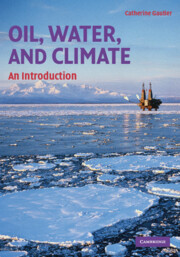Book contents
- Frontmatter
- Contents
- Foreword
- Introduction
- 1 Overview
- 2 Carbon Dioxide Emissions, Global Warming, and Water Resources
- 3 Population, Environmental Impacts, and Climate Change
- 4 Carbon Cycle and the Human Impact
- 5 Peak Oil, Energy, Water, and Climate
- 6 Oil Consumption and CO2 Emissions from Transportation
- 7 Oil, Economy, Power, and Conflicts
- 8 Energy Alternatives and Their Connection to Water and Climate
- 9 The Water Cycle and Global Warming
- 10 Fresh Water Availability, Sanitation Deficit, and Water Usage: Connection to Energy and Global Warming
- 11 Rivers, Lakes, Aquifers, and Dams: Relation to Energy and Climate
- 12 Water Contamination, Energy, and Climate
- 13 Geopolitics of Water and the International Situation
- 14 Water Alternatives
- 15 Global Climate Change: Observations, Modeling, and Predictions
- 16 Energy and Water Challenges and Solutions in a Changing Climate Framework: Commonality, Differences, and Connections
- References
- Index
8 - Energy Alternatives and Their Connection to Water and Climate
Published online by Cambridge University Press: 05 September 2012
- Frontmatter
- Contents
- Foreword
- Introduction
- 1 Overview
- 2 Carbon Dioxide Emissions, Global Warming, and Water Resources
- 3 Population, Environmental Impacts, and Climate Change
- 4 Carbon Cycle and the Human Impact
- 5 Peak Oil, Energy, Water, and Climate
- 6 Oil Consumption and CO2 Emissions from Transportation
- 7 Oil, Economy, Power, and Conflicts
- 8 Energy Alternatives and Their Connection to Water and Climate
- 9 The Water Cycle and Global Warming
- 10 Fresh Water Availability, Sanitation Deficit, and Water Usage: Connection to Energy and Global Warming
- 11 Rivers, Lakes, Aquifers, and Dams: Relation to Energy and Climate
- 12 Water Contamination, Energy, and Climate
- 13 Geopolitics of Water and the International Situation
- 14 Water Alternatives
- 15 Global Climate Change: Observations, Modeling, and Predictions
- 16 Energy and Water Challenges and Solutions in a Changing Climate Framework: Commonality, Differences, and Connections
- References
- Index
Summary
Various alternatives to oil exist, including coal, natural gas, nuclear energy, wind energy, solar energy, hydrogen, hydropower, biomass energy, and geothermal energy. Renewable energy alternatives have the potential to address the climate problem, but because of the size of today's energy demand, it will take a long time before they can be effective. A bridge fuel will be needed in the meantime to meet energy needs: clean coal, liquefied natural gas, and nuclear energy are the main candidates to replace oil at the scale needed, but all of these forms of energy will need to be developed in parallel.
Introduction
Although petroleum is the most popular fuel of choice today, several energy alternatives are already in use, including coal, natural gas, nuclear energy, hydropower, wind, solar, biofuels, geothermal energy, and hydrogen. It is, however, unlikely that any one of them or even all of them combined could replace oil in the near future and still allow the operation of the present energy system that supports the Western lifestyle. As each of these alternatives is reviewed, this chapter addresses their limitations and the difficulties in implementing them on a scale that would be necessary to replace oil. These difficulties arise because nearly everything in our lives is linked to oil and virtually all existing technologies presently available require oil. Most alternative systems of energy – including solar panels/solar nanotechnology, windmills, hydrogen fuel cells, biodiesel production facilities, and nuclear power plants – rely on sophisticated technology that, in one way or another, requires oil for production.
- Type
- Chapter
- Information
- Oil, Water, and ClimateAn Introduction, pp. 138 - 167Publisher: Cambridge University PressPrint publication year: 2008



